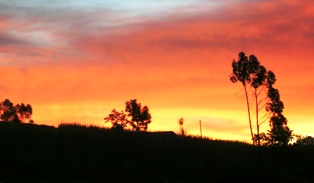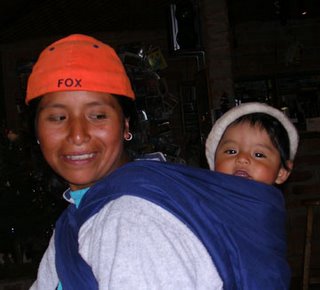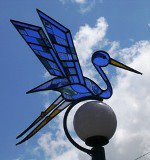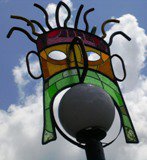Friday, February 24, 2006
Tamales
 When we returned from the market Chela got to work in the kitchen. She cooked the pork until it could be shredded, then she chopped and sauteed vegetables to mix with the pork. She mixed the cooking liquid from the pork with corn flour, then added both lard and butter and stirred it into a thick paste. Large green leaves (I don't know what they were. They looked like banana leaves) that we had purchased at the market were washed and made ready to accept the fillings. All the ingredients were organized on the kitchen table and we gathered around to begin assembling.
When we returned from the market Chela got to work in the kitchen. She cooked the pork until it could be shredded, then she chopped and sauteed vegetables to mix with the pork. She mixed the cooking liquid from the pork with corn flour, then added both lard and butter and stirred it into a thick paste. Large green leaves (I don't know what they were. They looked like banana leaves) that we had purchased at the market were washed and made ready to accept the fillings. All the ingredients were organized on the kitchen table and we gathered around to begin assembling.
We would take a leaf and break off the stem. It helps to run a spoon over the stiff center vein of the leaf to make it more pliable. Then you put a spoonful of the corn flour paste in the center of the leaf and pat it into a flattened circle. In the center of that you put a spoonful of the meat/vegetable mixture, then a sprinkle of chopped cooked egg and several raisins. Now comes the tricky part. You fold the sides of the leaf in so the dough encloses the filling, then fold the ends of the leaf under to make a neat packet.
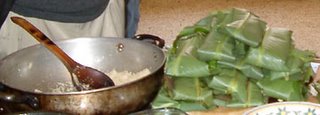
I have made Mexican style tamales and these were similar with a few differences. The vegetable/meat mixture had carrots, red peppers, fresh peas, cilantro and spices. The biggest difference was the use of the leaves to wrap them instead of cornhusks as Mexican tamales use.

When we had used up all the ingredients and had a nice stack of bright green tamale packets, Chela carefully loaded them into a big pot to steam them for an hour or so.

The tamales would be the first course of our New Years Eve dinner. Mmmmmmm.
Thursday, February 23, 2006
The market
 Chela asked if I would like to help make Tamales for New Years—of course I would! She said to be at her house by 9 the next morning and we would go to the market to get the ingredients, then we’d make tamales.
Chela asked if I would like to help make Tamales for New Years—of course I would! She said to be at her house by 9 the next morning and we would go to the market to get the ingredients, then we’d make tamales.When I arrived the next morning she was ready with her basket and we walked several blocks to a big market that covered a square block, both inside and outside a large open building. That’s Chela in the black and white shirt.

Chela hit the market like a woman on a mission. She seemed to know each of the vendors and greeted them warmly, as Ecuadoreans do, before getting down to it. Then she was all business, squeezing, sniffing, accepting or rejecting fruits, vegetables, meat; politely, but firmly insisting on their best price. The basket grew heavier and heavier.
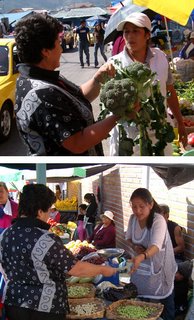
I was fascinated by the bags of different grains, the variety of beans and vegetables I had never seen before.

Inside the market there was a large section devoted to fresh meat. Chela bought pork for the tamales and fresh shrimp for ceviche.
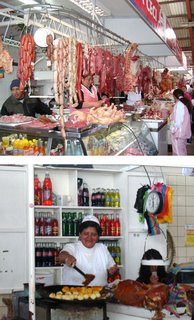
The woman in the stall with the colorful bottles of soda pop was frying llapingachos, which are fried patties of mashed potato with cheese inside—delicious! After I took her picture she handed me a llapingacho and a piece of the roast pork you see, on a paper napkin. She gave Chela a similar sample and we left the market happily enjoying our treats. 
Sunday, February 19, 2006
Ahh, beautiful Cuenca!
 The most beautiful city in Ecuador is Cuenca (KWEN - ka). It is an old, old city occupied, first, by the Cañari Indians, then the Incas, then the Spanish and now it is a UNESCO World Heritage site. It is renowned as a cultural center of Ecuador. We love Cuenca for the beautiful colonial architecture and the wonderful people.
The most beautiful city in Ecuador is Cuenca (KWEN - ka). It is an old, old city occupied, first, by the Cañari Indians, then the Incas, then the Spanish and now it is a UNESCO World Heritage site. It is renowned as a cultural center of Ecuador. We love Cuenca for the beautiful colonial architecture and the wonderful people.
Cuenca is south of Quito in the Central Highlands of Ecuador. We flew from Quito to Cuenca. It is a short trip by plane—less than an hour, but a long bus ride on the PanAmerican Highway, so well worth the airfare. We haven't taken the bus, but Cayo and Emily do, from time to time, and I think they say it is about 7 hours. We wanted to spend New Years in Cuenca and visit some of our favorite people and places while we were there.
Our son-in-law, Cayo, is from Cuenca, where much of his family still resides. We are always treated to such great hospitality when we go to Cuenca. Here is Cayo, with his mother, the amazing Chela, who is warm and funny and the best cook in Ecuador.

The heart of colonial Cuenca is Parque Calderón, the central plaza in front of the new Cathedral. You can have your picture taken, have your shoes shined, or sit and eat an ice cream and watch the Indigenous women, in their colorful embroidered skirts and panama hats, stroll through the plaza or the schoolgirls in their uniforms.
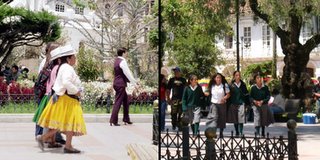
The architecture of Cuenca never ceases to impress me. The old buildings and grand homes along the river make Cuenca one of the loveliest cities in all the world to me.
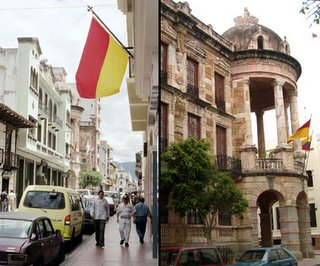

La Luna Objects
 Here are some photos I took at La Luna. As you can see, they did some Christmas decorating.
Here are some photos I took at La Luna. As you can see, they did some Christmas decorating. 
 The old phonograph was sitting under a bench and I put it on the bench for this picture. I don't know much about it, but it definitely appeared to be old and original.
The old phonograph was sitting under a bench and I put it on the bench for this picture. I don't know much about it, but it definitely appeared to be old and original.



Thursday, February 16, 2006
Parting thoughts of Otavalo
 I wanted to add a few random thoughts about Otavalo and the surrounding area before we take you off on another adventure. We have seen some amazing sunsets from La Luna. The ordinary view is of a large valley with spectacular mountains as a backdrop.
I wanted to add a few random thoughts about Otavalo and the surrounding area before we take you off on another adventure. We have seen some amazing sunsets from La Luna. The ordinary view is of a large valley with spectacular mountains as a backdrop. From La Luna, there are a number of hikes. We have never hiked a trail directly from the hostel, but we have driven a short distance up the hill to lake Mojanda. It is a high elevation so the walking is measured. The weather was good, but it was cold. The vegetation is typical of high elevations. Below is a picture of Emily and Cayo at the lake.
Before we leave Otavalo, I want to mention the place we used to stay. It is a hostal called Aya Huma and it is located in Peguchi, just up the hill from the town of Otavalo where the weaving factory is located. We have stayed there twice and I would recommend it. It is more humble and less expensive than La Luna, but it is located in the middle of where the local indiginous artisans live. They have a small bar/restaurant where there is usually wonderful live folk music and dancing on Saturday nights. The term Aya Huma refers to a local nature spirit whose image appears regularly in this region. You will see the Aya Huma in the logo of the Hostal on their web site and also in one of the glass decorations on a street light in Otavalo. 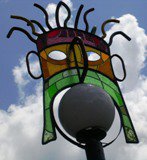
Wednesday, February 15, 2006
Weaving studio in Peguche
 Just outside Otavalo is the little town of Peguche which is the source of much of the beautiful weaving that Ecuador is famed for.
Just outside Otavalo is the little town of Peguche which is the source of much of the beautiful weaving that Ecuador is famed for.
We visited a weaving studio in Peguche just across the street from this exceptionally beautiful church.
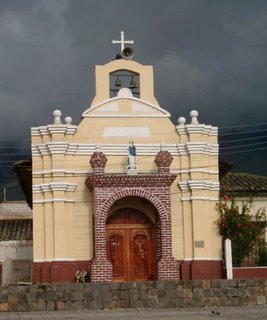 The woman who greeted us took us into the studio to see all the aspects of the weavings. The weaving done in this studio is a higher quality than most that is sold at the Otavalo market. These weavings are sold in the better galleries in Ecuador.
The woman who greeted us took us into the studio to see all the aspects of the weavings. The weaving done in this studio is a higher quality than most that is sold at the Otavalo market. These weavings are sold in the better galleries in Ecuador.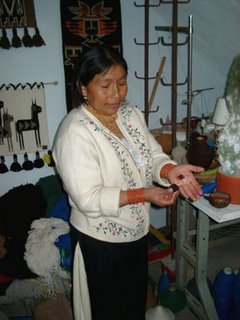 She showed us the raw materials that are used for dying the wool yarns, including achiote and Cochineal, a beetle that lives on cactuses.
She showed us the raw materials that are used for dying the wool yarns, including achiote and Cochineal, a beetle that lives on cactuses.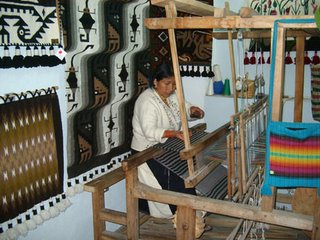 Here she is weaving fabric for tote bags.
Here she is weaving fabric for tote bags. On this loom she weaves tapestries.
On this loom she weaves tapestries. Here are some of the beautiful weavings they produce in this studio.
Here are some of the beautiful weavings they produce in this studio.La Luna
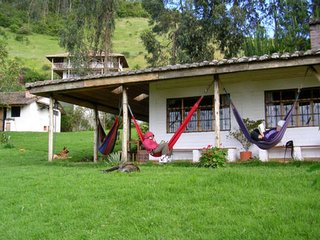
 We have stayed at two different places near Otavalo and enjoyed both, but I think we are really partial to La Luna, which is located just outside Otavalo very high up in the mountains. It is rustic and home-y and the setting is so beautiful. It cools off in the evenings and each of the rooms we have stayed in has a fireplace and a young man who works there will come and start a fire for you. This year's heavy rains had made all the wood so wet that fire starting was difficult and once we did get a fire going in our room it filled the room with smoke—not so nice as the crackling little fires we remembered from previous visits.
We have stayed at two different places near Otavalo and enjoyed both, but I think we are really partial to La Luna, which is located just outside Otavalo very high up in the mountains. It is rustic and home-y and the setting is so beautiful. It cools off in the evenings and each of the rooms we have stayed in has a fireplace and a young man who works there will come and start a fire for you. This year's heavy rains had made all the wood so wet that fire starting was difficult and once we did get a fire going in our room it filled the room with smoke—not so nice as the crackling little fires we remembered from previous visits.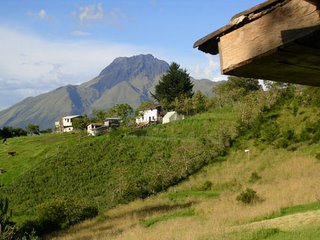 The main lodge has a nice room with tables and chairs and a fireplace, as well as a lounge area with movies and books.
The main lodge has a nice room with tables and chairs and a fireplace, as well as a lounge area with movies and books.Outside are hammocks for napping or reading. The views in all directions are spectacular, including two volcanos.
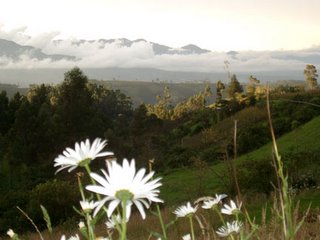
There is a young couple that works at LaLuna. The young man is the one who comes and builds the fires. He also seems to do all kinds of maintenance and gardening. The young woman is sweet and shy and always smiling. She takes your food orders, cleans, calls taxis and seems to work closely with the kitchen staff. We were surprised to learn that she had a baby since we visited in May and she did all her work with the baby on her back. He was a beautiful, little doll baby—all smiles and giggles.
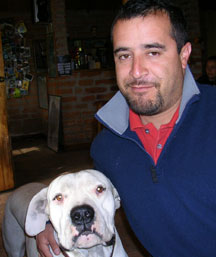 A fixture at LaLuna are the dogs. I think there are four large, gentle dogs. My favorite is "Milky" the big white dog. Emily said she thought he was an Argentine dogo breed. I have found these dogs on the internet and believe she is correct. I found the history of these dogs quite interesting. I was surprised to learn they were bred to hunt and fight. Milky is a gentle, very easy-going dog, that even Cayo likes and Cayo doesn't much like dogs! The folks at La Luna
A fixture at LaLuna are the dogs. I think there are four large, gentle dogs. My favorite is "Milky" the big white dog. Emily said she thought he was an Argentine dogo breed. I have found these dogs on the internet and believe she is correct. I found the history of these dogs quite interesting. I was surprised to learn they were bred to hunt and fight. Milky is a gentle, very easy-going dog, that even Cayo likes and Cayo doesn't much like dogs! The folks at La Luna 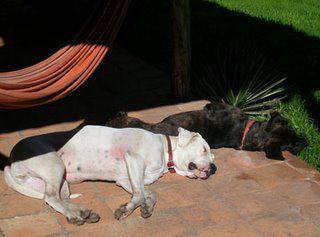 will let you take one or more of the dogs out hiking with you if you want.
will let you take one or more of the dogs out hiking with you if you want.They seem quite content to lay around in the sun or play a game of fetch-the-stick with the guests.
